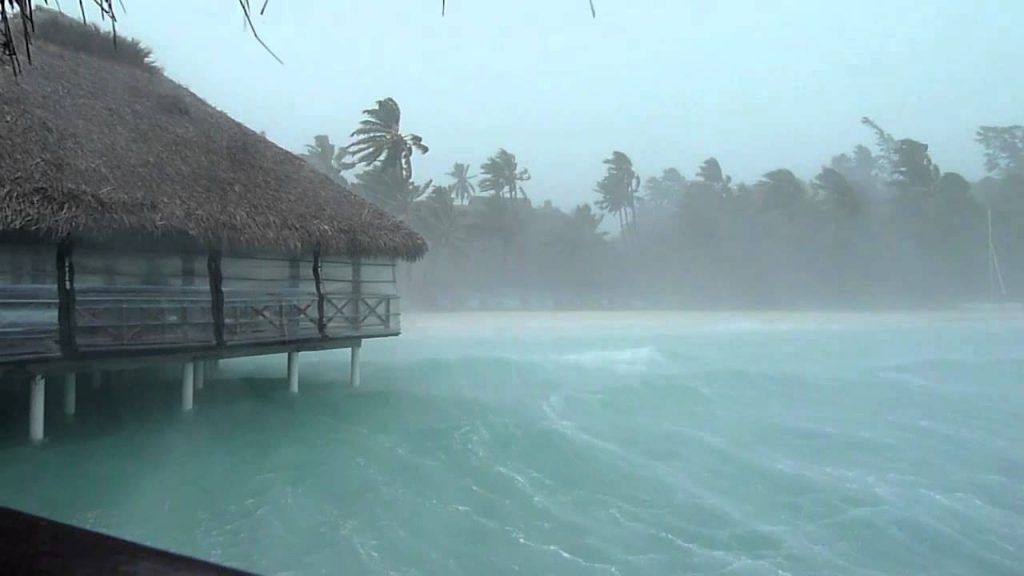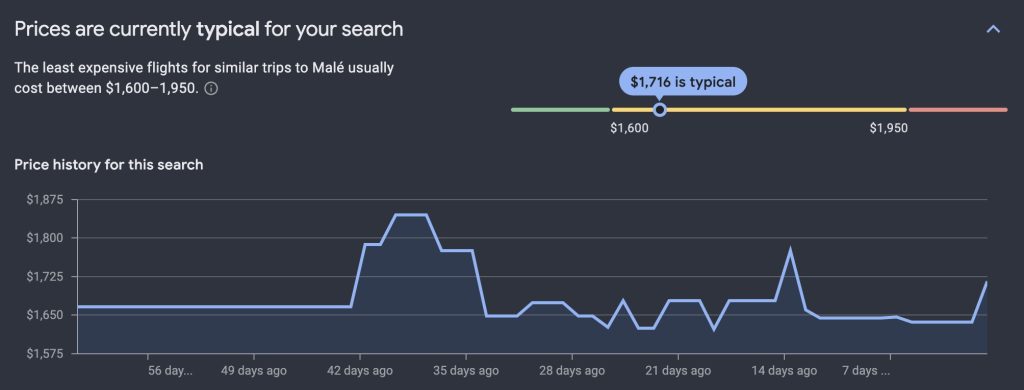
Maldives is a tropical paradise with beautiful beaches, clear water, and a wide variety of fish and other sea life. It is a hotspot for newlyweds, families, and those just trying to get a break from their busy schedules. However, there are times when it is preferable to stay away from the Maldives if you don’t want to ruin your trip. If you wish to avoid any unfavorable conditions, it is essential to be aware of the worst time to visit Maldives.
The average temperatures in the Maldives range from 23 to 31 degrees Celsius (74 to 88 degrees Fahrenheit), making it a hot and sunny year-round vacation spot.
The Worst Time to Visit Maldives
Monsoon season, which occurs between May and December, is the worst time to visit the Maldives. During this time, heavy rain might fall for many hours or even days straight as a result of the monsoon winds that sweep in from the southwest.
While precipitation is prevalent throughout the year in the Maldives, certain islands may get up to 10 inches in a single month during the monsoon season. It might be difficult to see underwater, and the waves can be harmful to outdoor sports like swimming, snorkeling, and diving.

As if the monsoon rains were not bad enough, the winds may also generate choppy waters, which can be hazardous for boats and prevent visitors from enjoying water-based activities. Strong currents and large waves provide a danger to swimmers and divers who are not proficient in these conditions.
During the rainy season, certain hotels may decide to cancel water sports as a precaution. As an added complication, bad weather often results in flight cancellations or delays as well.
The Maldives might be at risk from natural disasters like storms and floods. In 2021, a violent spell of rain caused flooding in various parts of Maldives. This made it unsafe to travel and enjoy outdoor activities. In times of severe weather, it is crucial to keep up with forecasts and heed the advice of the Maldives Meteorological Service.
Before venturing out on water-based sports like diving or snorkeling, make sure to check the weather and sea conditions.
Also, check out our expert advice on the worst time to visit Dubai.
Safety Tips for Bad Weather in Maldives
If you really must visit the Maldives during the Monsoon season, please keep the following safety tips in mind:
- The risk of floods and landslides makes it best to stay out of areas like far-by islands.
- Bring along a few necessities like a battery-powered flashlight, a first aid kit, and some extra batteries.
- When there is a chance of heavy waves, it is best to stay out of the water.
- If you are planning on spending the night at a resort, inquire about the procedures in place in the event of inclement weather.
- Ensure that your travel insurance policy must cover emergency medical and evacuation costs in the case of a natural catastrophe.
- Your passport and insurance details should also be stored in a watertight container.
- The mosquito population also spikes during the monsoons, which may spread illnesses like dengue fever and malaria. Keep a mosquito repellant with you at all times.
- In the event of an emergency, you should also make preparations for how you would contact your loved ones back home.

Most Expensive Time to Visit Maldives
The Maldives is not a budget-friendly vacation spot. The Maldives see their highest visitor volume during the months of December and February. As a result, travel costs skyrocket, particularly over the holidays (when many hotels have minimum stays of five or more nights for the Christmas and New Year seasons).
Unlike other popular tourist locations, the Maldives will not be overrun with people during high season since each resort has its own island.
Flight prices to the Maldives fluctuate based on variables including time of year, airline, and point of departure. The cheapest round-trip price from Los Angeles to Maldives includes one stop and costs US$1,400, while the most expensive option, flying Business Class, costs US$6,587.

Prices at hotels are different based on location, hotel brand, room size, and number of facilities. The cost of a hotel room may range from cheap to expensive, depending on the location. In December, the cost per night may reach a high of almost $800 if the hotel is a 5-star offering all the services.
Expect to spend around the $200-400 range the rest of the year, with the exception of November (when prices are in the mid-$500 level).
Related: Worst Time To Visit Costa Rica
Most Crowded Months to Visit Maldives
The months from December through April, when the weather is milder, and the holidays are in full swing, are the busiest for tourists in the Maldives. The clean seas are wonderful for diving and snorkeling at this time of year, and the weather is perfect for exploring the outdoors.
Prices for lodging, transportation, and entertainment may all increase dramatically from their off-season lows during the peak travel season. In addition, there may be an excessive amount of people in certain high-traffic locations, which may be annoying.

Now imagine you want to go to the Maldives at the busiest time of the year for tourists. If that is the case, you should plan ahead and reserve your lodgings and any excursions you want to partake in.
Staying on a native island rather than a resort might be cheaper and give you a more genuine taste of the Maldives. The shoulder season offers cheaper rates and fewer tourists than the peak summer and winter seasons.
When is the Worst Time to Visit Maldives: According to Other Tourists?
Last year, Sara Anwar visited the Maldives during the wet season. She stated, “The clouds would roll in, it would pelt down for a time, and then the storm would go on. There were a few cloudy days in there for me. Because of the noise levels during storms, I will not advise anyone to stay in an overwater cottage”.
Zalah Khan also visited the Maldives earlier and suggested that “My trip to the Maldives during the monsoons was a huge mistake. Due to the potential for rough seas, several of the activities, such as snorkeling, diving, sailing, and surfing, were unavailable. Heavy rains fell during our visit, canceling any plans for outside activities”.
When to Visit Maldives: Worst Months to Visit Maldives
Discover the perfect time to visit the Maldives with our month-by-month analysis, ensuring an unforgettable experience in this tropical paradise.

January
Water activities like snorkeling, diving, and surfing thrive in the 25°C to 30°C temperatures and low humidity of the Maldives in January. However, the fantastic weather also brings crowds and increased expenses, so plan ahead.
February
Temperature-wise, February is not much different from January. The water is smooth and clean, ideal for snorkeling and visiting nearby islands. The same high pricing and plenty of tourists should be anticipated as in January.
March
In March, both the temperature and the humidity level start to climb. Temperatures will range from 26°C to 31°C, and shower is possible on occasion. But the sea is always tranquil and clear, making it perfect for all kinds of aquatic activities.
April
Temperatures in the Maldives average between 27 and 32 degrees Celsius in April, making it the warmest month of the year. Expect some rain before the end of the month and excessive humidity that will make the temperature seem hotter. April is fantastic for aquatic activities despite the heat since visibility is high.
May
The southwest monsoon season begins in May, bringing with it an increase in rain and a continuation of the sticky conditions. It is important to check the forecast before venturing out to sea since the water is unpredictable. However, if surfing is your thing, it is a good time.
Suggested Reading: Worst Time to Visit Barbados – Infamous Rainy Season
June
Heavy rain and thunderstorms are common in the Maldives throughout the month of June. However, the temperature remains pleasant, with highs of 26°C to 31°C. Check the forecast before setting out on any outdoor adventures. Despite the less-than-ideal weather, June is a good month for scuba diving since the water is so clear.
July
Rain and high humidity are expected in the Maldives throughout the month of July as the monsoon season continues. The sea may be unpredictable, so it is important to have an open mind before setting off.
August
August is often the wettest month of the monsoon season in the Maldives. The weather in August is unpredictable, with heavy rain followed by sunny periods that can be used to enjoy some time outside. Temperature remains between 25 and 29 degrees Celsius.
September
In general, September ushers in drier and less humid conditions. The sea is smooth and clean, and the conditions are getting better for swimming and other water sports. Explore the stunning underwater world through snorkeling and diving adventures, and enjoy quieter beaches and lower accommodation rates as the weather transitions towards the off-peak season.
October
With the end of the monsoons in October, the Maldives enjoy pleasant temperatures, abundant sunshine, and relatively low humidity. Temperatures average between 25 and 30 degrees Celsius, and because it is not the high season, you will not have to pay peak rates. Immerse yourself in cultural experiences, visit local islands, and take part in traditional festivities while enjoying pleasant temperatures and occasional rainfall.
November
The dry season in the Maldives begins in November, bringing with it bright, sunny days and little humidity. The water is clean and tranquil, ideal for island hopping. Engage in water-based activities like kayaking and paddleboarding, appreciate the idyllic landscapes, and enjoy the comfortable climate before the high season starts.
December
The weather in December is typically mild, sunny, and dry with little humidity. Keep in mind that it is the Christmas season, when everyone is on vacation, and rates and availability of services are likely to increase. Get your vacation scheduled as soon as you can!
Conclusion
In conclusion, the Maldives is a stunning travel destination, If you want to avoid potential disruptions, it’s crucial to steer clear of the worst time to visit the Maldives, which is during the months of May through October. This period coincides with the monsoon season when the weather and seas become unpredictable and potentially dangerous. Severe rainfall, high winds, and choppy seas are common during this time, requiring travelers to be prepared and cautious.
Similarly, traveling at the busiest times of the year is challenging for those on a tight budget due to the increased crowds and higher expenses.
To make the most of your time in the Maldives while minimizing the effects of bad weather, organize your vacation around local weather trends.
Worst Time to Visit Maldives - FAQs
The worst time to visit the Maldives in terms of weather is during the rainy season, which typically occurs from May to October.
Yes, the Maldives can experience frequent storms and cyclones during the southwest monsoon season, which is generally from June to August.
Yes, visiting during the worst time can affect water visibility for snorkeling and diving due to increased rainfall and cloudiness.
The Maldives tends to experience higher tourist traffic and overcrowding during the Christmas and New Year period, as well as during school holidays in December and January.





